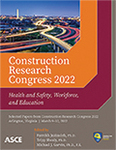Enhancing Workers’ Vigilance to Electrical Hazards through a Virtually Simulated Accident
Publication: Construction Research Congress 2022
ABSTRACT
Electrocution is one of the major causes of fatalities in the construction industry. Despite periodic safety training aimed at retaining workers’ vigilance (i.e., sustained attention) to electrical hazards, workers tend to fail to maintain vigilance toward frequent encounters with electrical hazards. Providing an effective intervention that restores workers’ vigilance is thus critical to reducing electrocution accidents. To this end, this study proposes a Virtual Reality (VR) safety training environment that exposes workers to repeated electrical hazards and simulates an electrocution accident when workers come in contact with the hazards. A pilot experiment was conducted, and participants’ vigilance (i.e., eye fixations on the hazard) was measured using eye-tracking sensors. The results reveal the potential effect of experiencing VR-simulated electrocution on enhancing workers’ vigilance to electrical hazards. The outcomes of this study will lay the foundation for further studies to employ VR as a safety training environment that allows workers to experience a simulated electrocution, thereby contributing to a potential reduction in fatal electrocutions.
Get full access to this article
View all available purchase options and get full access to this chapter.
REFERENCES
Baby, T., Madhu, G., and Renjith, V. R. (2021). “Occupational electrical accidents: Assessing the role of personal and safety climate factors.” Safety Science, 139, 105229.
Bhandari, S., and Hallowell, M. R. (2017). “Emotional engagement in safety training: impact of naturalistic injury simulations on the emotional state of construction workers.” Journal of construction engineering and management, American Society of Civil Engineers, 143(12), 04017090, https://doi.org/10.1061/(ASCE)CO.1943-7862.0001405.
Bureau of Labor Statistics. (2020). “Number and rate of fatal work injuries, by industry sector.” <https://www.bls.gov/charts/census-of-fatal-occupational-injuries/number-and-rate-of-fatal-work-injuries-by-industry.htm>(May 11, 2021).
Castillo-Rosa, J., Suárez-Cebador, M., Rubio-Romero, J. C., and Aguado, J. A. (2017). “Personal factors and consequences of electrical occupational accidents in the primary, secondary and tertiary sectors.” Safety Science, 91, 286–297, https://doi.org/10.1016/j.ssci.2016.08.021.
CPWR (The Center for Construction Research and Training). (2018). The construction chart book: the US construction industry and its workers. The Center for Construction Research and Training Silver Spring, MD. (Accessed May 2021).
Deng, M., Chan, A. H. S., Wu, F., and Sun, L. (2018). “Depth perception, dark adaptation, vigilance and accident proneness of Chinese coal mine workers.” International Journal of Occupational Safety and Ergonomics, Taylor & Francis, 24(3), 450–456.
Esterman, M., Grosso, M., Liu, G., Mitko, A., Morris, R., and DeGutis, J. (2016). “Anticipation of Monetary Reward Can Attenuate the Vigilance Decrement.” PLOS ONE, Public Library of Science, 11(7), e0159741, https://doi.org/10.1016/j.ssci.2016.08.021.
Grier, R. A., Warm, J. S., Dember, W. N., Matthews, G., Galinsky, T. L., Szalma, J. L., and Parasuraman, R. (2003). “The Vigilance Decrement Reflects Limitations in Effortful Attention, Not Mindlessness.” Human Factors, 45(3), 349–359.
Hasanzadeh, S., Esmaeili, B., and Dodd, M. D. (2017). “Impact of construction workers’ hazard identification skills on their visual attention.” Journal of construction engineering and management, American Society of Civil Engineers, 143(10), 04017070.
Hasanzadeh, S., de la Garza, J. M., and Geller, E. S. (2020). “Latent Effect of Safety Interventions.” Journal of Construction Engineering and Management, American Society of Civil Engineers, 146(5), 04020033, https://doi.org/10.1061/(ASCE)CO.1943-7862.0001812.
Hubal, R., Mitroff, S. R., Cain, M. S., Scott, B., and DeWitt, R. (2010). “Simulating a vigilance task: Extensible technology for baggage security assessment and training.” 2010 IEEE International Conference on Technologies for Homeland Security (HST), IEEE, 543–548.
Janicak, C. A. (2008). “Occupational fatalities due to electrocutions in the construction industry.” Journal of Safety Research, 39(6), 617–621.
Jeelani, I., Albert, A., and Han, K. (2020). “Improving Safety Performance in Construction Using Eye-Tracking, Visual Data Analytics, and Virtual Reality.” American Society of Civil Engineers, 395–404, https://doi.org/10.1061/9780784482872.043.
Jeelani, I., Han, K., and Albert, A. (2018). “Automating and scaling personalized safety training using eye-tracking data.” Automation in Construction, 93, 63–77.
Ke, J., Zhang, M., Luo, X., and Chen, J. (2021). “Monitoring distraction of construction workers caused by noise using a wearable Electroencephalography (EEG) device.” Automation in Construction, 125, 103598, https://doi.org/10.1016/j.autcon.2021.103598.
Kim, N., and Ahn, C. R. (2020). “Using a Virtual Reality-based Experiment Environment to Examine Risk Habituation in Construction Safety.” ISARC. Proceedings of the International Symposium on Automation and Robotics in Construction, IAARC Publications, 1176–1182, https://doi.org/10.22260/ISARC2020/0161.
Kim, N., Kim, J., and Ahn, C. R. (2021). “Predicting workers’ inattentiveness to struck-by hazards by monitoring biosignals during a construction task: A virtual reality experiment.” Advanced Engineering Informatics, 49, 101359.
Koustellis, J. D., Halevidis, C. D., Polykrati, A. D., and Bourkas, P. D. (2013). “Analysis of a fatal electrical injury due to improper switch operation.” Safety Science, 53, 226–232.
Lee, Y.-C., Shariatfar, M., Rashidi, A., and Lee, H. W. (2020). “Evidence-driven sound detection for prenotification and identification of construction safety hazards and accidents.” Automation in Construction, 113, 103127. https://doi.org/10.1016/j.autcon.2020.103127.
OSHA. (2011). “Construction Focus Four: Outreach Training Packet.” OSHA Training Institute, Arlington Heights, IL. <https://www.osha.gov/sites/default/files/constrfocusfour-introduction.pdf>(May 11, 2021).
Pan, B., Hembrooke, H. A., Gay, G. K., Granka, L. A., Feusner, M. K., and Newman, J. K. (2004). “The determinants of web page viewing behavior: an eye-tracking study.” Proceedings of the 2004 symposium on Eye tracking research & applications, 147–154.
Rensink, R. A., O’Regan, J. K., and Clark, J. J. (1997). “To see or not to see: The need for attention to perceive changes in scenes.” Psychological science, SAGE Publications Sage CA: Los Angeles, CA, 8(5), 368–373, https://doi.org/10.1111/j.1467-9280.1997.tb00427.x.
Taylor, A. J., McGwin, G., Valent, F., and Rue, L. W. (2002). “Fatal occupational electrocutions in the United States.” Injury Prevention, BMJ Publishing Group Ltd, 8(4), 306–312.
Wang, D., Li, H., and Chen, J. (2019). “Detecting and measuring construction workers’ vigilance through hybrid kinematic-EEG signals.” Automation in Construction, 100, 11–23.
Warm, J. S. (1984). Sustained attention in human performance. John Wiley & Sons Inc.
Information & Authors
Information
Published In
History
Published online: Mar 7, 2022
Authors
Metrics & Citations
Metrics
Citations
Download citation
If you have the appropriate software installed, you can download article citation data to the citation manager of your choice. Simply select your manager software from the list below and click Download.
